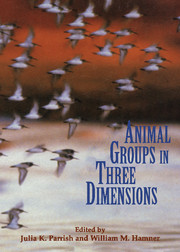Book contents
- Frontmatter
- Contents
- List of contributors
- Acknowledgments
- 1 Introduction – From individuals to aggregations: Unifying properties, global framework, and the holy grails of congregation
- Part one Imaging and measurement
- 2 Methods for three-dimensional sensing of animals
- 3 Analytical and digital photogrammetry
- 4 Acoustic visualization of three-dimensional animal aggregations in the ocean
- 5 Three-dimensional structure and dynamics of bird flocks
- 6 Three-dimensional measurements of swarming mosquitoes: A probabilistic model, measuring system, and example results
- Part two Analysis
- Part three Behavioral ecology and evolution
- Part four Models
- References
- Subject index
- Taxonomic index
4 - Acoustic visualization of three-dimensional animal aggregations in the ocean
from Part one - Imaging and measurement
Published online by Cambridge University Press: 01 June 2010
- Frontmatter
- Contents
- List of contributors
- Acknowledgments
- 1 Introduction – From individuals to aggregations: Unifying properties, global framework, and the holy grails of congregation
- Part one Imaging and measurement
- 2 Methods for three-dimensional sensing of animals
- 3 Analytical and digital photogrammetry
- 4 Acoustic visualization of three-dimensional animal aggregations in the ocean
- 5 Three-dimensional structure and dynamics of bird flocks
- 6 Three-dimensional measurements of swarming mosquitoes: A probabilistic model, measuring system, and example results
- Part two Analysis
- Part three Behavioral ecology and evolution
- Part four Models
- References
- Subject index
- Taxonomic index
Summary
Introduction
Pelagic animals exist in a three-dimensional fluid medium and are continuously subjected to the physical processes of advection and turbulent mixing. Despite the tendencies of turbulence to mix and homogenize scalar properties in the ocean, most distributions of pelagic animals exhibit patchiness over a wide range of spatial and temporal scales (Haury et al. 1978; Powell 1989; Steele 1991; Levin et al. 1993). Since many pelagic animals are active swimmers, it is perhaps not surprising that the power spectra of their spatial distributions deviate, at least on smaller scales, from those of passive scalar properties such as sea surface temperature and chlorophyll fluorescence (Levin 1990). The patchiness of pelagic animal distributions results from the interaction between physical processes at work on the fluid and animal aggregation responses to biotic and abiotic cues in their fluid environment (Omori & Hamner 1982; Mackas et al. 1985; Hamner 1988; Greene et al. 1994). This interaction between physics and biology is both complex and fascinating; its study will demand new methods in oceanography and ethology which are more sophisticated than those brought to bear on the subject in the past.
Three fundamental problems complicate efforts to study patchiness and animal aggregations in the oceanic environment. First, the ocean presents humans with a relatively hostile environment within which to work. Second, the ocean is largely opaque to light and other forms of electromagnetic radiation. Third, the distributions of pelagic animals are highly dynamic, continuously changing in both space and time. All three of these problems make it difficult to observe or sample pelagic animal distributions without confounding spatial and temporal patterns.
- Type
- Chapter
- Information
- Animal Groups in Three DimensionsHow Species Aggregate, pp. 61 - 67Publisher: Cambridge University PressPrint publication year: 1997



